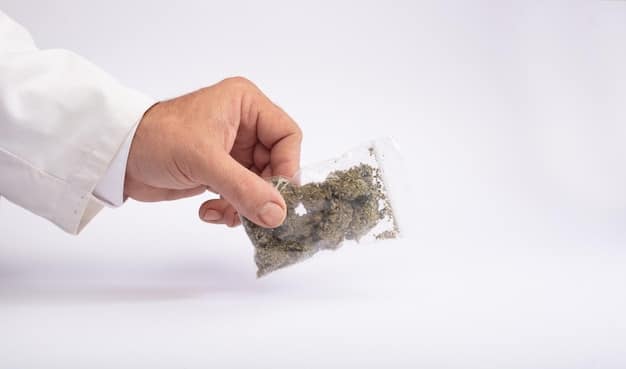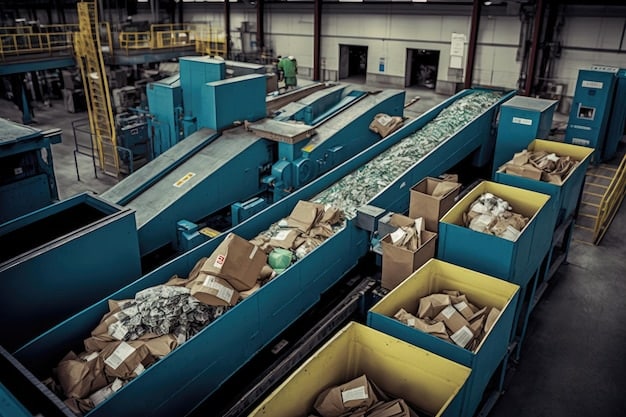US Companies Drive Innovation in Sustainable Packaging Technologies

US Companies Lead the Way in Developing Sustainable Packaging Technologies by innovating with biodegradable materials, reducing plastic use, and improving recycling processes, setting global standards for eco-friendly packaging solutions.
The pressing need for environmental responsibility has spurred a wave of innovation in the packaging industry. US Companies Lead the Way in Developing Sustainable Packaging Technologies, responding to consumer demand and regulatory pressures with groundbreaking solutions. This evolution goes beyond simple recycling, diving into biodegradable materials, reduced plastic consumption, and circular economy models.
From startups to established corporations, American businesses are at the forefront, investing in research and development to create packaging that minimizes environmental impact. This article explores how these companies are revolutionizing the packaging landscape, offering insights into the materials, technologies, and strategies driving this crucial transformation. These efforts aim not only to protect the environment but also to enhance brand reputation and meet the evolving expectations of conscious consumers.
How US Companies Lead the Way in Developing Sustainable Packaging Technologies
The commitment to sustainability is no longer a niche trend but a core business imperative. US companies are taking the lead, investing significantly in technologies that reduce waste, minimize carbon footprints, and promote a circular economy. This section delves into the key areas where these companies are making a substantial impact.
Innovative Materials for Sustainable Packaging
One of the most promising developments is the shift towards innovative, sustainable materials. These alternatives aim to replace traditional plastics with options that are biodegradable, compostable, or made from renewable resources. Companies are exploring a wide range of materials to achieve these goals.
- Biodegradable Polymers: Derived from plant-based sources like cornstarch or sugarcane, these polymers break down naturally in the environment.
- Mushroom Packaging: Grown from mycelium, the root structure of mushrooms, this packaging is strong, lightweight, and fully compostable.
- Seaweed Packaging: Seaweed-based packaging is another promising alternative, offering biodegradability and the potential to reduce ocean plastic pollution.
- Recycled Content: Using recycled materials in packaging reduces the demand for virgin resources and diverts waste from landfills.

These material innovations are crucial for reducing the environmental impact of packaging. By embracing these alternatives, companies are not only minimizing waste but also contributing to a more sustainable future. Research and development in this area continue to expand, promising even more effective solutions in the years to come.
Advancements in Packaging Design and Technology
Beyond materials, significant advancements in packaging design and technology are driving sustainability. US companies are adopting new approaches to minimize material usage, improve recyclability, and enhance the overall efficiency of packaging processes. This innovation is focused on creating packaging that is both functional and environmentally responsible.
Minimizing Material Usage
Reducing the amount of material used in packaging is a primary goal. This can be achieved through smarter design, lighter materials, and innovative technologies that optimize packaging structures. US companies are at the forefront of these efforts, implementing strategies that minimize waste without compromising product protection.
Enhancing Recyclability
Designing packaging for recyclability is another critical aspect. This involves using materials that are easily recyclable and avoiding combinations of materials that complicate the recycling process. Many companies are working to standardize packaging materials to improve recycling rates and reduce contamination.
Smart Packaging Solutions
Technology is also playing a role in sustainable packaging. Smart packaging solutions, such as QR codes and NFC tags, can provide consumers with information about recycling, product sourcing, and proper disposal methods. These technologies enhance transparency and empower consumers to make more informed choices.

These advancements in design and technology are essential for creating a more sustainable packaging ecosystem. By minimizing material usage, enhancing recyclability, and leveraging smart technologies, companies are reducing waste and promoting a circular economy. These efforts are helping to transform the packaging industry into a more environmentally responsible sector.
The Role of Policy and Consumer Behavior
While technological innovation is vital, policy and consumer behavior also play crucial roles in driving the adoption of sustainable packaging. US companies are navigating a complex landscape of regulations and consumer preferences as they strive to create more environmentally friendly packaging solutions. How these factors influence the industry’s trajectory is critical.
Government Regulations and Incentives
Government regulations are increasingly pushing companies toward sustainable practices. Policies such as extended producer responsibility (EPR) laws, which hold companies accountable for the end-of-life management of their products, are becoming more common. Additionally, incentives like tax breaks and grants are encouraging companies to invest in sustainable packaging technologies.
Consumer Demand for Eco-Friendly Packaging
Consumer demand for sustainable products is a major driver of change. A growing number of consumers are actively seeking out brands that prioritize environmental responsibility, and packaging is a key factor in their purchasing decisions. This demand is pushing companies to adopt more sustainable practices to attract and retain customers.
Education and Awareness
Raising consumer awareness about sustainable packaging is essential. Many consumers are unsure about what types of packaging are recyclable or compostable, leading to confusion and improper disposal. Education initiatives and clear labeling can help consumers make more informed choices and improve recycling rates.
Challenges and Opportunities in Sustainable Packaging
Despite the progress made, the transition to sustainable packaging is not without its challenges. US companies face various hurdles, including cost considerations, technological limitations, and infrastructure gaps. However, these challenges also present significant opportunities for innovation and growth. Addressing these issues collaboratively is key to further advancement.
Cost Considerations
Sustainable packaging materials and technologies often come with higher upfront costs compared to traditional options. However, as demand increases and production scales up, these costs are expected to decline. Companies are also finding ways to offset these costs through efficiency gains and reduced waste disposal expenses.
Technological Limitations
While there have been significant advancements in sustainable packaging technologies, some limitations remain. For example, certain biodegradable materials may not perform as well as traditional plastics in terms of durability and barrier properties. Ongoing research and development are needed to overcome these limitations and improve the performance of sustainable packaging materials.
Infrastructure Gaps
The infrastructure for collecting, sorting, and processing recyclable and compostable materials varies widely across the United States. In some areas, recycling facilities may not be equipped to handle certain types of sustainable packaging, leading to disposal in landfills. Addressing these infrastructure gaps is crucial for realizing the full potential of sustainable packaging solutions.
Opportunities for Innovation
The challenges in sustainable packaging also present significant opportunities for innovation. Companies are developing new materials, technologies, and business models to overcome these hurdles. Collaboration between industry, government, and research institutions is essential for fostering innovation and accelerating the transition to a more sustainable packaging ecosystem.
Future Trends in Sustainable Packaging
The sustainable packaging landscape is constantly evolving, driven by technological advancements, changing consumer preferences, and increasing regulatory pressures. Several key trends are expected to shape the future of this industry, pointing toward even more innovative and sustainable solutions. Anticipating and adapting to these trends will be crucial for companies aiming to lead in this space.
Increased Use of Bioplastics
Bioplastics, derived from renewable resources, are expected to play an increasingly important role in sustainable packaging. As technology improves and production costs decline, bioplastics will become more competitive with traditional plastics, offering a viable alternative for a wider range of applications.
Adoption of Circular Economy Principles
The circular economy, which emphasizes reducing waste and maximizing resource utilization, is gaining traction in the packaging industry. Companies are adopting strategies such as designing packaging for reuse, repair, and recycling to minimize waste and keep materials in circulation for as long as possible.
Focus on Compostable Packaging
Compostable packaging, which breaks down naturally in composting facilities, is another key trend. As more cities and communities invest in composting infrastructure, the demand for compostable packaging is expected to increase. This will drive innovation in compostable materials and packaging designs.
Integration of Digital Technologies
Digital technologies, such as blockchain and IoT, are being integrated into packaging to improve traceability, transparency, and supply chain efficiency. These technologies can help companies track the environmental impact of their packaging and provide consumers with information about the sourcing, production, and disposal of products. With the combination of this technology, US Companies Lead the Way in Developing Sustainable Packaging Technologies.
| Key Point | Brief Description |
|---|---|
| 🌱 Innovative Materials | Use of biodegradable polymers, mushroom packaging, and seaweed pouches. |
| ♻️ Enhanced Recyclability | Designing packaging for recyclability and minimizing material usage. |
| ⚖️ Policy & Demand | Government regulations and consumer demand driving sustainable practices. |
| 💡 Future Trends | Increased bioplastics, circular economy, and digital integration are expected. |
Frequently Asked Questions
Innovative materials include biodegradable polymers made from plant-based sources, mushroom packaging grown from mycelium, and seaweed-based packaging. These alternatives reduce reliance on traditional plastics.
Government regulations, such as extended producer responsibility (EPR) laws, hold companies accountable for the end-of-life management of their products. Incentives like tax breaks also encourage sustainable packaging investments.
Consumer demand for eco-friendly products drives companies to adopt sustainable packaging. Consumers actively seek brands prioritizing environmental responsibility, influencing purchasing decisions and promoting change.
Challenges include higher upfront costs for sustainable materials, technological limitations in performance compared to traditional plastics, and infrastructure gaps for recycling and composting.
Digital technologies like blockchain enhance traceability, transparency, and supply chain efficiency. Circular economy principles reduce waste and maximize resource utilization; compostable packaging allows for eco-friendly waste management.
Conclusion
US Companies Lead the Way in Developing Sustainable Packaging Technologies by driving innovation in materials, design, and technology. While challenges remain in cost and infrastructure, the commitment to sustainability and the pursuit of innovative solutions are setting a positive trajectory for the industry.
As consumer demand and regulatory pressures increase, US companies are well-positioned to continue leading the charge in creating a more sustainable and environmentally responsible packaging ecosystem. By embracing these advancements, businesses can not only reduce their environmental impact but also enhance their brand reputation and meet the evolving expectations of conscious consumers.





